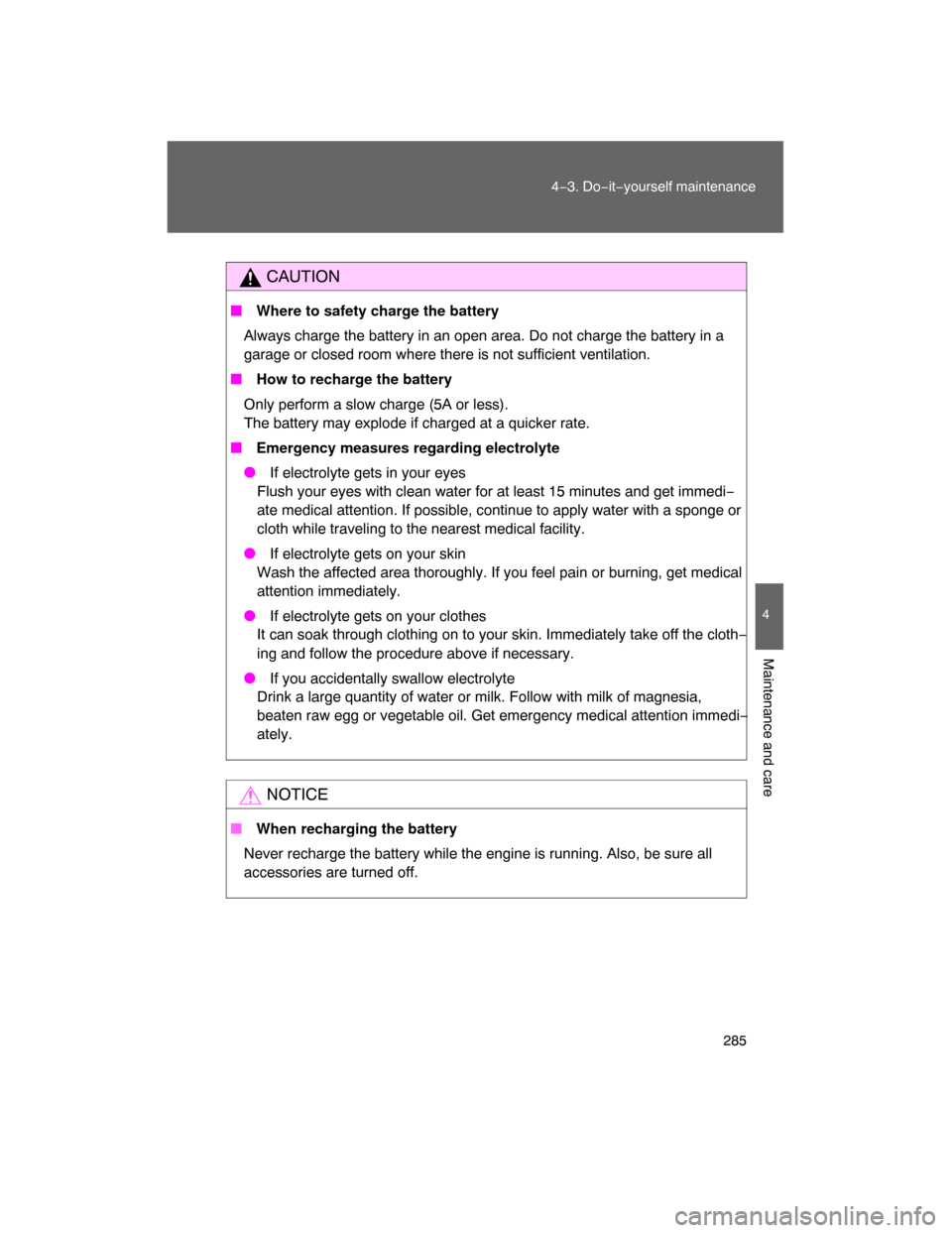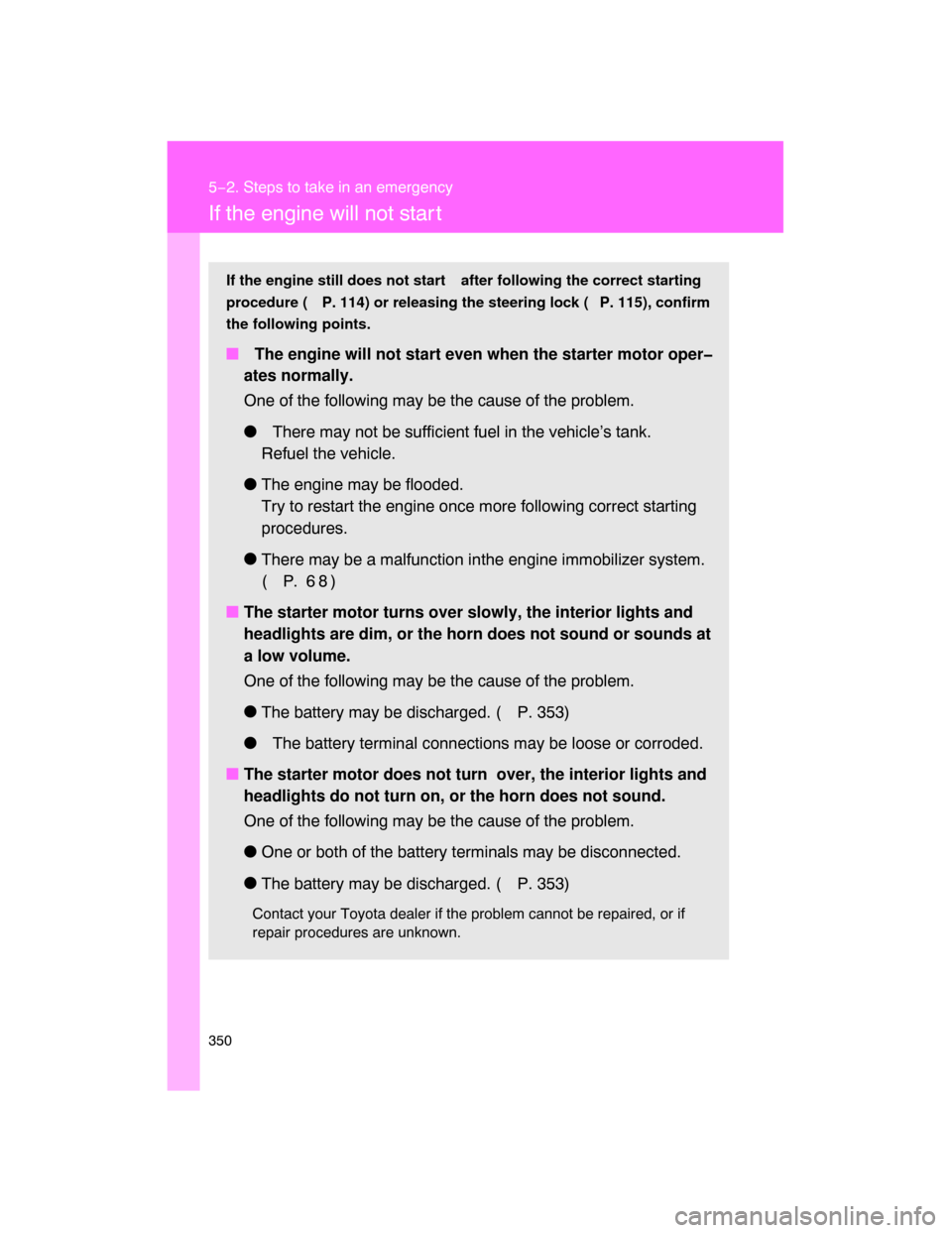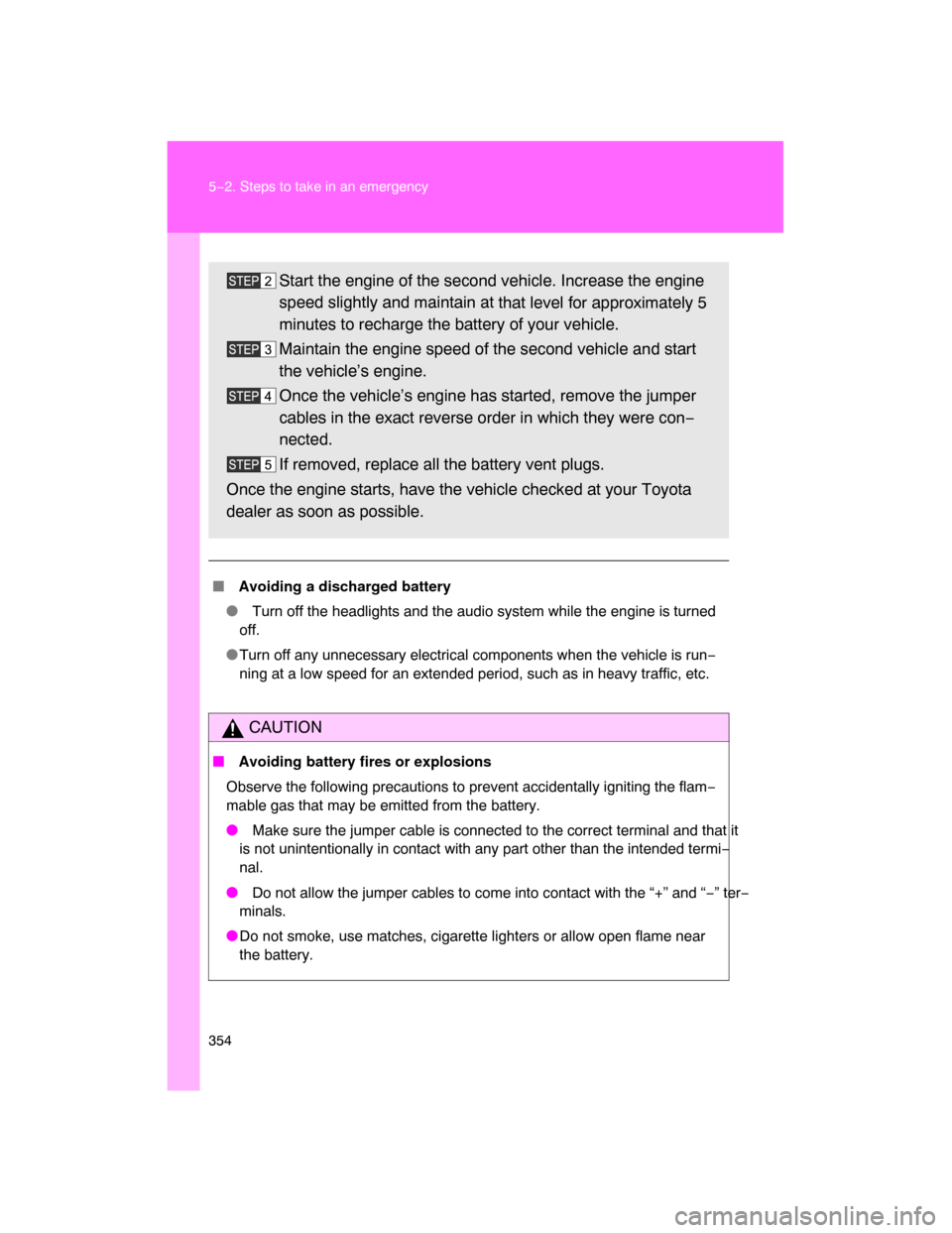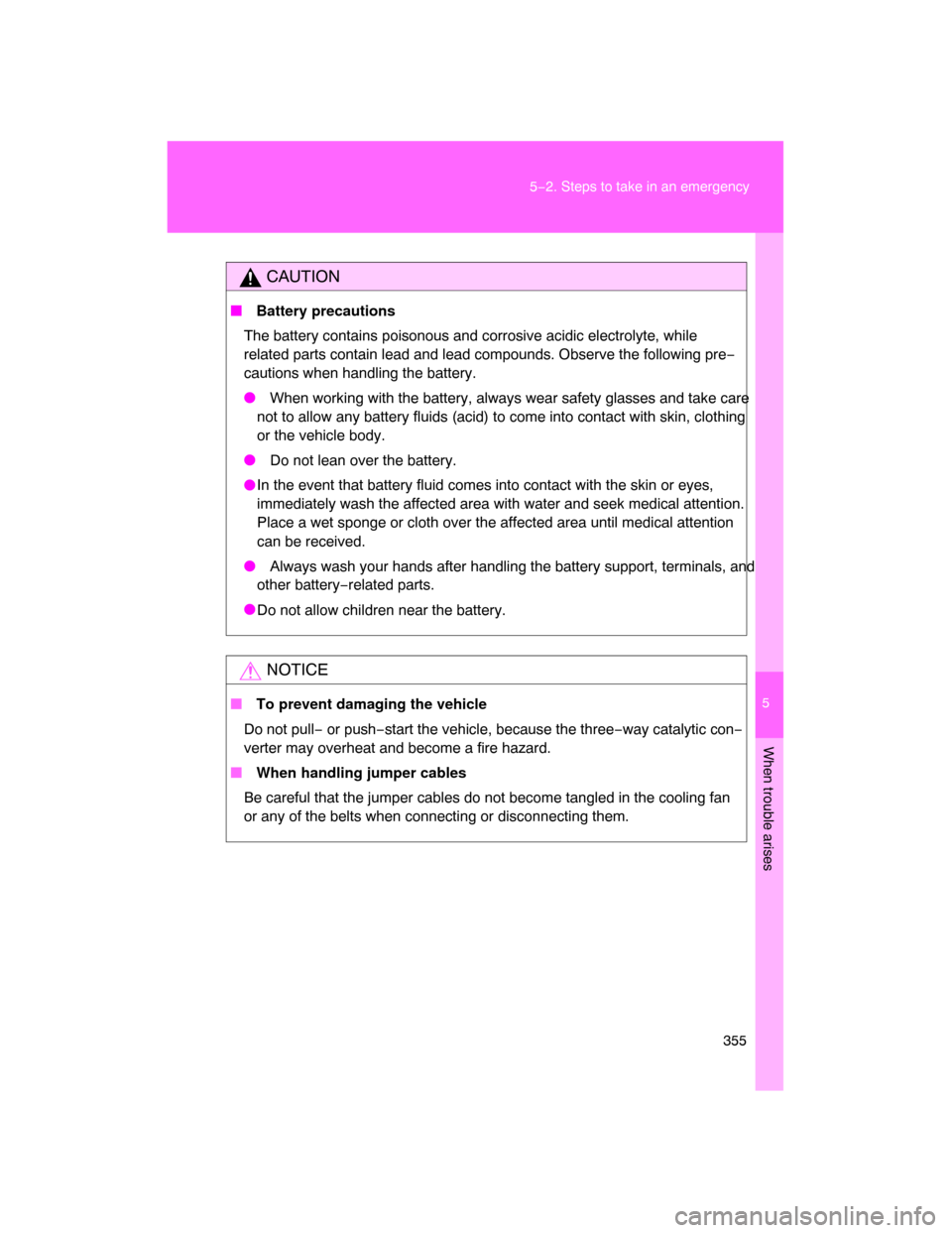Page 281 of 400

285
4−3. Do−it−yourself maintenance
4
Maintenance and care
CAUTION
� Where to safety charge the battery
Always charge the battery in an open area. Do not charge the battery in a
garage or closed room where there is not sufficient ventilation.
� How to recharge the battery
Only perform a slow charge (5A or less).
The battery may explode if charged at a quicker rate.
� Emergency measures regarding electrolyte
� If electrolyte gets in your eyes
Flush your eyes with clean water for at least 15 minutes and get immedi−
ate medical attention. If possible, continue to apply water with a sponge or
cloth while traveling to the nearest medical facility.
� If electrolyte gets on your skin
Wash the affected area thoroughly. If you feel pain or burning, get medical
attention immediately.
� If electrolyte gets on your clothes
It can soak through clothing on to your skin. Immediately take off the cloth−
ing and follow the procedure above if necessary.
� If you accidentally swallow electrolyte
Drink a large quantity of water or milk. Follow with milk of magnesia,
beaten raw egg or vegetable oil. Get emergency medical attention immedi−
ately.
NOTICE
� When recharging the battery
Never recharge the battery while the engine is running. Also, be sure all
accessories are turned off.
Page 297 of 400
301
4−3. Do−it−yourself maintenance
4
Maintenance and care
Key batter y
Replace the battery with a new one if it is discharged.
� You will need the following items:
� Small Phillips−head screwdriver
�Lithium battery CR1616
�
Replacing the battery
Remove the screw and cover.
Push the cover in the arrow
direction.
Remove the module.
Remove the 2 screws to take
out the lid.
Insert a new battery with the
“+” terminal facing up.
Page 298 of 400
302 4−3. Do−it−yourself maintenance
� If the key battery is discharged
The following symptoms may occur.
�The wireless remote control will not function properly.
�The operational range is reduced.
�Use a CR1616 lithium battery
�Batteries can be purchased at your Toyota dealer, jewelers, or camera
stores.
� Replace only with the same or equivalent type recommended by your
Toyota dealer.
�
Dispose of used batteries according to the local laws.
CAUTION
� Removed battery and other parts
Keep away from children.
These parts are small and if swallowed by a child they can cause choking.
NOTICE
� For normal operation after replacing the battery
Observe the following precautions to prevent accidents.
�Always work with dry hands.
Moisture may cause the battery to rust.
� Do not touch or move any other components inside the remote control.
�
Do not bend either of the battery terminals.
Page 345 of 400

350
5−2. Steps to take in an emergency
If the engine will not star t
If the engine still does not start after following the correct starting
procedure ( P. 114) or releasing the steering lock ( P. 115), confirm
the following points.
� The engine will not start even when the starter motor oper�
ates normally.
One of the following may be the cause of the problem.
� There may not be sufficient fuel in the vehicle’s tank.
Refuel the vehicle.
�The engine may be flooded.
Try to restart the engine once more following correct starting
procedures.
�
There may be a malfunction inthe engine immobilizer system.
(P. 6 8 )
�
The starter motor turns over slowly, the interior lights and
headlights are dim, or the horn does not sound or sounds at
a low volume.
One of the following may be the cause of the problem.
�
The battery may be discharged. ( P. 353)
� The battery terminal connections may be loose or corroded.
�The starter motor does not turn over, the interior lights and
headlights do not turn on, or the horn does not sound.
One of the following may be the cause of the problem.
�
One or both of the battery terminals may be disconnected.
�
The battery may be discharged. ( P. 353)
Contact your Toyota dealer if the problem cannot be repaired, or if
repair procedures are unknown.
Page 348 of 400
5
When trouble arises
353
5−2. Steps to take in an emergency
If the vehicle batter y is discharged
The following procedures may be u sed to start the engine if the
vehicle’s battery is discharged.
You can call your Toyota dealer, Roadside Assistance or Toyota
Customer Service Assistance.
If you have a set of jumper (or boo ster) cables and a second vehi−
cle with a 12−volt battery, you can
jump start your Toyota following
the steps below.
Connecting the jumper cables
If required, remove all vent plugs from the booster and dis−
charged batteries. Lay a cloth over the open vents on the batter−
ies. (This helps reduce the explosion hazard, personal injuries
and burns.)
Positive (+) battery terminal on your vehicle
Positive (+) battery terminal on the second vehicle
Negative (−) battery terminal on the second vehicle
Connect the jumper cable to gr
ound on your vehicle as shown in
the illustration.
Page 349 of 400

354 5−2. Steps to take in an emergency
� Avoiding a discharged battery
� Turn off the headlights and the audio system while the engine is turned
off.
�
Turn off any unnecessary electrical components when the vehicle is run−
ning at a low speed for an extended period, such as in heavy traffic, etc.
CAUTION
� Avoiding battery fires or explosions
Observe the following precautions to prevent accidentally igniting the flam−
mable gas that may be emitted from the battery.
� Make sure the jumper cable is connected to the correct terminal and that it
is not unintentionally in contact with any part other than the intended termi−
nal.
� Do not allow the jumper cables to come into contact with the “+” and “−” ter−
minals.
�
Do not smoke, use matches, cigarette lighters or allow open flame near
the battery.
Start the engine of the second vehicle. Increase the engine
speed slightly and maintain at
that level for approximately 5
minutes to recharge the battery of your vehicle.
Maintain the engine speed of the second vehicle and start
the vehicle’s engine.
Once the vehicle’s engine has started, remove the jumper
cables in the exact reverse order in which they were con−
nected.
If removed, replace all the battery vent plugs.
Once the engine starts, have the vehicle checked at your Toyota
dealer as soon as possible.
Page 350 of 400

5
When trouble arises
355 5−2. Steps to take in an emergency
CAUTION
� Battery precautions
The battery contains poisonous and corrosive acidic electrolyte, while
related parts contain lead and lead compounds. Observe the following pre−
cautions when handling the battery.
� When working with the battery, always wear safety glasses and take care
not to allow any battery fluids (acid) to come into contact with skin, clothing
or the vehicle body.
� Do not lean over the battery.
�In the event that battery fluid comes into contact with the skin or eyes,
immediately wash the affected area with water and seek medical attention.
Place a wet sponge or cloth over the affected area until medical attention
can be received.
� Always wash your hands after handling the battery support, terminals, and
other battery−related parts.
�
Do not allow children near the battery.
NOTICE
� To prevent damaging the vehicle
Do not pull− or push−start the vehicle, because the three−way catalytic con−
verter may overheat and become a fire hazard.
� When handling jumper cables
Be careful that the jumper cables do not become tangled in the cooling fan
or any of the belts when connecting or disconnecting them.
Page 360 of 400
366 6−1. Specifications
Cooling system
Ignition system
Electrical system
Capacity
Vehicles with an automatic transmission
10.4 qt. (9.8 L, 8.6 Imp.qt.)
Vehicles with a manual transmission
9.9 qt. (9.4 L, 8.3 Imp. qt.)
Coolant typeUse either of the following.
�“Toyota Super Long Life Coolant”
�Similar high−quality ethylene glycol−based
non−silicate, non−amine, non−nitrite, and
non−borate coolant with long−life hybrid
organic acid technology
Do not use plain water alone.
Spark plug
Make DENSO
NGK
K20HR−U11
LFR6C11
Gap 0.043 in. (1.1 mm)
Battery
Open voltage at
68
F (20 C):12.6 12.8 V Fully charged
12.2 12.4 V Half charged
11 . 8 12.0 V Discharged
(Voltage checked 20 minutes after
the key is removed with all the lights
turned off)
Charging rates 5 A max.